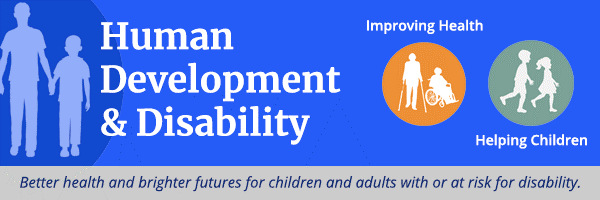DHDD Newsletter – January 2020

A Note from the DHDD Director:
Dear colleagues –
Happy New Year! I hope you all had a wonderful holiday season and are looking forward to what 2020 will bring! Together we accomplished so much in the past year and I am excited to continue to work collaboratively with you all to help the audiences we serve achieve optimal health. DHDD has many exciting projects planned for this year, along with several publications under development that will help add valuable information to the disability-related literature. I wish you all much health and happiness in 2020 and look forward to seeing many of you in-person this year.
Sincerely,
Dr. Georgina Peacock, Director, DHDD
In the Spotlight
Dr. Coleen Boyle Announces Retirement as NCBDDD Director

At the end of January 2020, Dr. Coleen Boyle will retire from CDC concluding her 35-year career with the agency.
Dr. Boyle started her career at CDC shortly after graduate school working as an epidemiologist on Agent Orange projects. As she tells it, it was a job that she assumed would last just a few years and then she would move on. Yet the job transformed into a successful CDC career that has touched many lives and families through her important contributions to the science on birth defects and developmental disabilities. Dr. Boyle has held progressive roles as a scientist and as a leader, including as an epidemiologist, an associate director of science, a division director, and culminating for the past 9 years, as the Director of the National Center on Birth Defects and Developmental Disabilities. She has overseen NCBDDD’s expansion to address topics including Emerging Threats to Mothers and Babies, Neonatal Abstinence Syndrome, and Healthy Athletes.
Starting February 3, Dr. Amanda Cohn will serve as Acting Director of NCBDDD.
Funding Opportunity for Early Hearing Detection and Intervention

CDC has released a Notice of Funding Opportunity (NOFO) for a new four-year project called “Improving Timely Documentation, Reporting, and Analysis of Diagnostic and Intervention Data through Optimization of EHDI Surveillance.” This NOFO aims to advance the capacity of states to actively track infants to ensure they receive essential diagnostic services and enrolled in early intervention by
- optimizing their Early Hearing Detection and Intervention (EHDI) Information Systems and
- expanding their ability to report, analyze, and use patient-level (iEHDI) data.
Funding Opportunity for Intellectual and Developmental Disabilities Research

The Patient-Centered Outcomes Research Institute (PCORI) is accepting letters of intent and applications for a new funding cycle launching in 2020. This funding opportunity includes a particular interest in proposals focused on intellectual and developmental disabilities. PCORI funds projects that answer patient-centered questions about health and health care. Research findings are intended to inform decisions by patients, caregivers, clinicians, and other healthcare stakeholders. For more information on what is needed to submit an application, please visit the PCORI website. The submission deadline for letters of intent is February 4 by 5PM ET; the application deadline is May 5 by 5PM ET.
Milestone Tracker App Promotion
In the January print issue of AAP News, the American Academy of Pediatrics published our “tip-in” promotion of the Milestone Tracker app and other tools to support developmental surveillance in pediatric clinics. The tip-in capitalizes on AAP’s recently published guidelines on developmental surveillance and screening, and it can be easily removed and used as a poster in clinic waiting areas or exam rooms.
Publications
Disparities in Documented Diagnoses of Autism Spectrum Disorder

Congratulations to Lisa Wiggins and her co-authors from DHDD’s Child Development and Disability Branch for the online publication of their article “Disparities in Documented Diagnoses of Autism Spectrum Disorder Based on Demographic, Individual, and Service Factors” in Autism Research. Researchers used surveillance data collected from 11 communities in the United States to compare 8-year old children with and without a clinical diagnosis of Autism Spectrum Disorder (ASD) who were identified in the Autism and Developmental Disabilities Monitoring Network, or ADDM. Among nearly 4,500 children, 1, 135 (25%) had ASD indicators without having an ASD diagnosis. More than half (N=628; 55%) of the children without a documented ASD diagnosis were not known to receive ASD services in public school.
The results of this study highlight factors associated with disparities in ASD diagnosis and stress the need to implement appropriate interventions to reduce those disparities across communities.
Also read a couple of stories about this publication
USA Today: Autism rate climbs, but as many as 1 in 5 NJ kids with the disorder still goes undiagnosed.
Disability Scoop: A Quarter Of Kids With Autism Go Undiagnosed, Study Suggests.
Wandering Among Preschool Children with and without Autism Spectrum Disorder
Scientists from DHDD’s Child Development and Disability Branch co-authored “Wandering Among Preschool Children with and without Autism Spectrum Disorder” in the Journal of Developmental & Behavioral Pediatrics.
Using data from the Study to Explore Early Development (SEED) and consistent with previous studies on this topic, researchers found that children with ASD were significantly more likely to wander than children in other study groups. Specifically,
- Among children with confirmed ASD in this study, more than half, or about 60 percent, were reported to wander;
- Among children with a previous but unconfirmed ASD diagnosis, about 41 percent were reported to wander;
- Among children with other developmental disabilities, about 22 percent were reported to wander; and
- Among children in the general population, about 12 and a half percent were reported to wander.

Additionally, mood, anxiety, attention, and oppositional problems, as well as a very low developmental level were associated with wandering behavior independent of ASD status.
These results may facilitate discussions between parents and providers about safety, prevention, and interventions, which may improve the lives of children who wander and their families.
DHDD’S mission is to lead inclusive programs to optimize the health and development of children and adults with, or at risk for, disabilities.
